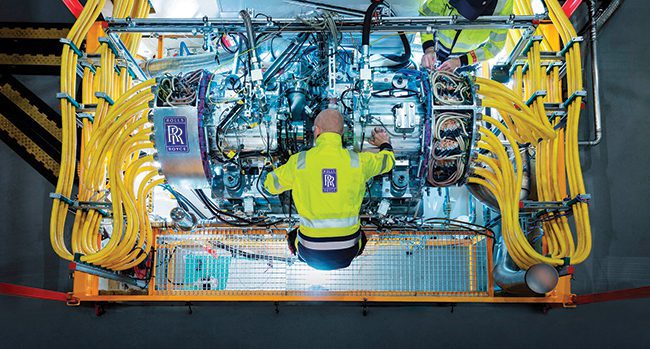Rolls-Royce Sets Megawatt Milestone for Hybrid-Electric Aircraft System
Bracing for explosive growth in the electrification of mobility, UK-based engineering giant Rolls-Royce is developing various all-electric and hybrid-electric drive systems for aircraft. At one of its most-watched hybrid-electric aero power and propulsion system programs, work is underway to develop a formidable system that could power future aircraft at a megawatt-scale. In December, the program marked a notable triumph just weeks after commencing initial testing.
 |
|
Rolls-Royce’s Power Generation System 1 demonstrator in December delivered more than a megawatt of power just weeks after testing began at the newly renovated Testbed 108 in Bristol, UK. Testing is continuing with the aim of reaching up to 2.5 MW. Courtesy: Rolls-Royce |
The company on Dec. 7 said its Power Generation System 1 (PGS1) had delivered more than a megawatt of power at its newly renovated Testbed 108 in Bristol, UK (Figure 4). The milestone is a “great achievement” for the system, which has been designed with a 2.5 MW capacity, noted Adam Newman, chief project engineer at Rolls-Royce’s Aviation Futures. “Our generator is about the size of a beer keg, yet it has already produced enough electricity to continuously power around 1,000 homes—that is really taking technology to new levels.”
The World’s Most Powerful Flying Generator
The triumph is especially important for Rolls-Royce because the PGS1 demonstrator derives from the E-Fan X technology demonstrator project, which Rolls-Royce began developing jointly with aircraft manufacturing giant Airbus. The pioneering E-Fan X project involved removing a single engine from an Avro RJ100 aircraft (a 100-seat regional jet) and replacing it with a hybrid-electric propulsion system powered by a AE2100 gas turbine, a 2.5-MW generator, and a battery system. But while Rolls-Royce and Airbus had hoped the system would become “the world’s most powerful flying generator,” the E-Fan X partnership concluded in 2021 “when both parties recognized there was no requirement to create an actual aircraft for test flight,” Rolls-Royce said.
Rolls-Royce, however, continued development of the 2.5-MW generator, continuing work at its bespoke facility in Trondheim, Norway. “When future hybrid-electric aircraft opportunities emerge in the megawatt and above class, we want to be as prepared as we can be to offer a ready-made solution,” said Newman.
The PGS1 project kicked off in June 2021 with testing of the AE2100 engine element, the specialist controls, and thermal management system. The company later brought in a fully operational generator and 3,000-volt power electronics system.
Key Challenges: Managing Weight and Thermal Management
“The challenge of this type of hybrid technology at this level of power is really about weight and thermal management. Batteries weigh more than kerosene, and once you have added on cables, power electronics, and the cooling systems for each component, you also have unavoidable increased complexity,” explained Riona Armesmith, chief project engineer of Rolls-Royce Hybrid Electric Propulsion. “So, we have to make PGS1 as light, reliable, and simple to operate as possible. And if we achieve that we will be in a great position, with a fully-integrated and ground-tested power and thermal management system. It means whenever anyone comes forward with a hybrid or all-electric aircraft concept requiring megawatt-power, we will be ready to go.”
The company says the PGS1 program will be an essential part of its sustainability strategy, which includes developing innovative electrical power and propulsion systems, as well as further improving gas turbine performance and promoting the use of sustainable aviation fuels. Rolls-Royce also has several kilowatt initiatives underway. In November 2021, its “Spirit of Innovation” aircraft developed under its “Accelerating the Electrification of Flight” project clocked a maximum speed of 387.4 miles per hour—possibly marking a record for the world’s fastest all-electric vehicle. Under another project, Rolls-Royce will pilot an all-electric vertical take-off and landing (eVTOL) vehicle—essentially a four-person flying taxi—that will feature a 100-kW-class lift and push electrical propulsion unit.

According to the company, electrification of mobility is a promising new frontier that could help reshape aircraft design. All-electric and hybrid-electric drive systems allow aircraft to fly with power from renewable resources or fuel cells instead of only with fossil fuels, and make new aircraft designs possible, it said. “Electrical technology will allow us to increase aircraft efficiency, reduce aircraft emissions and fuel consumption, and build aircraft with very low noise levels and new, short and vertical take-off and landing capabilities.”
Much progress has already been achieved, the company noted. “Light sport and training aircraft already fly electrically today. Electric commuter class aircraft and air taxis are on the way, and we aim to see the first all-electric aircraft transport people and goods in the middle of the decade.” The company acknowledges it’s a bold vision. “But it is one worth doing for a connected future protecting our planet’s environment for generations to come,” it said.
—Sonal Patel is a POWER senior associate editor (@sonalcpatel, @POWERmagazine).